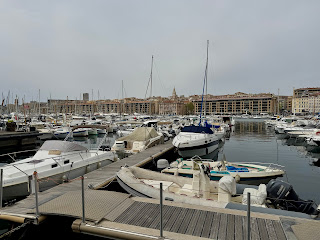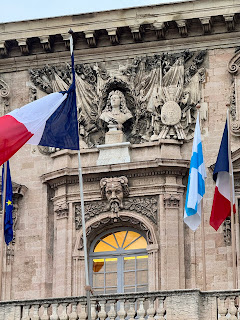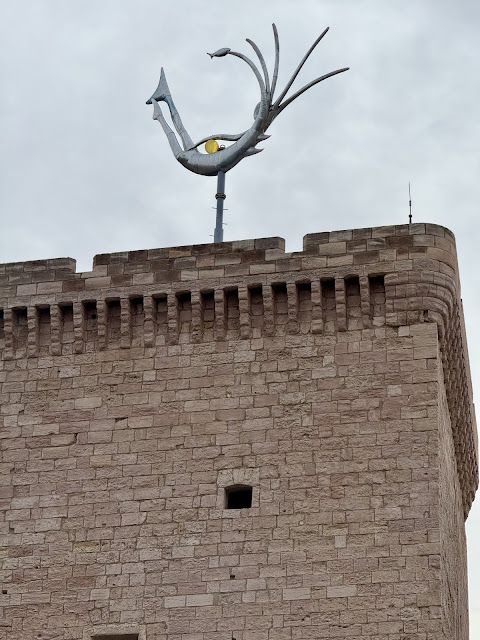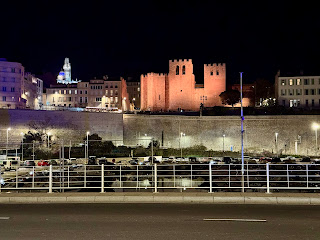If you've been to France, chances are, you haven't been here – France's second largest city, the oldest city in France. It sits right by the Mediterranean. The food is famously good, yet it's a victim of bad reputation, bad history. Marseille, as it turns out, is exactly the kind of place I like. – Anthony Bourdain (Parts Unknown, 6x02)
We are headed to the Provence region of France to meet family, so a stop in Marseille (pop 877,215 in 2022) is in order. The airport is some distance from the city center, so we take the train to Marseille-Saint-Charles (early 20th century). The station is large, and difficult to navigate. We find an elevator to street level, but once outside, it's almost impossible to avoid at least a few stairs. However, it's quite a beautiful building.
We make our way southwest, through the neighborhood known as Belsunce, which is, as advertised, a dirty and gritty. Looking for a place for lunch, we skirt Le Vieux-Port (old port), where the sidewalks are uneven, narrow, and crowded. We pass three separate McDonald's franchises (?) at the inside corner of the Port area.
The mouth of the Port is framed by the Fort Saint-Nicolas to the south and Fort Sant-Jean to the north (both 17th century). The Port itself is packed with boats, their masts and aerials sprouting from the water's edges.
Along the southern quay, the Quai de Rive-Neuve, the road opens into a cloverleaf and crossed by a bridge connecting a smaller inner harbor. This area is crossed with tunnels and archways knotting the traffic of people, cyclists, boats, and cars. The ancient bell towers of the Abbay Saint-Victor (11th century) look down from the bluff.
After dispatching our luggage and unpacking, we head out for a walk before dinner to the Palais du Pharo (19th century), which crowns a steep mound to the west of Fort Saint-Jean. The seabirds, pigeons, joggers, and students share the grassy Jardin du Pharo. The park is clearly a favorite for locals, with its small playground and outstanding views; the tourist crowd seems thin here.
Turning, we get our first good look at the Basilique Nore-Dame de la Garde (19th century), and realize the famous golden figure of 'Our Lady' is covered in scaffolding. It's good that the Church should care for Her, but it is a disappointment.
The Monument aux Héros et Victimes de la Mer (André Alexandre Verdilhan, 1923) overlooks Le Vieux-Port, with a dramatic wave of copper washing over the stone blocks.
Dinner is near Le Vieux-Port, so we dive back into the throng. We have enough time before our reservation to walk the north side of the marina, the Quai du Port. In the corner, across from the McDonald's trio, os L'Ombriére du Vieux-Port (Norman Foster and Michel Desvigne, 2013), a mirrored 'umbrella' that provides shelter and fascination for the tourists and commuters waiting for the ferries. The crisp edges allow the reflected image to float like a hole in the sky.
The Église Saint-Ferréol le Augustins (16th century), a Renaissance-era church, is in the other corner of Le Vieux-Port and looks completely out of place – though, most likely, it pre-dates everything else here (the facade is 19th century).
The Madonna in the aedicula reminds us to look for the Nore-Dame de la Garde, who stands directly south on a steep peak. All along the Quai du Port, She is visible above the blocks of restaurants and hotels.
Mairie de Marseille (17th century), the old City Hall and now the Hôtel de Ville, is another building that interrupts the mid-rise buildings along the docks. The flags of the EU, France, Provence (red and yellow) , and Marseille (blue cross) are echoed in the banners of the deep-relief carved stone.
At the western end of the Port is La Tour du Roi René (15th century), which is presently topped by a striking, curled sculpture, 'Icare, Us, Elle' (Laure Prouvost, 2025 – Art Basel article). It is strangely reminiscent of the galos we see on the tops of the towers in Portugal.
We walk back past the winches and containers needed to maintain this working port – a mix of ancient towers and coast guard stations, museums and ferries, sculptures and sea gulls.
Dinner is near the Art Deco styled Opéra Municipal (20th century), covered in allegorical figures.
After a filling dinner, we linger in Le Vieux-Port area, which remains crowded and active well into the night. We people-watch: there is music and laughing, eating and drinking, and locals walking their dogs. Lights bathe the buildings and the boats in carnival colors, and everyone is doing their own thing.
Marseille was once the hub, the rough and tumble principal port, for France's colonies such as Tunisia, Morocco, and Algeria. As a result, the sights and smells of Africa permeate the city. There has been attempts to dissuade me from, oh Marseille, you don't want to go there. And yet I come here, correct me if I'm wrong, it is a beautiful city. It smells good. You smell the different pastries, the tagine, the bouillabaisse and bourride. And it's an extraordinary looking city, and the people are really interesting looking. – Anthony Bourdain (Parts Unknown, 6x02)










































No comments:
Post a Comment